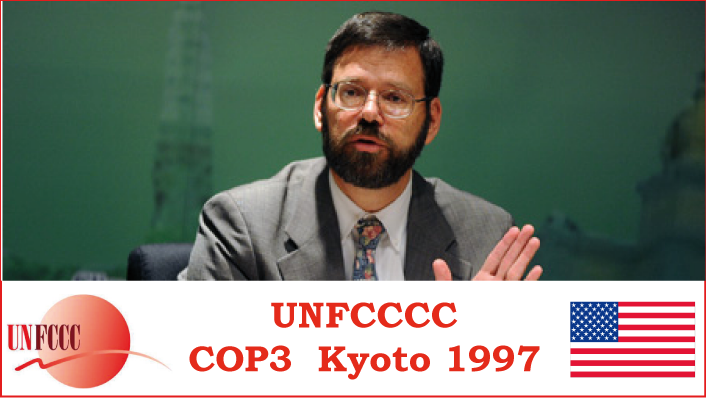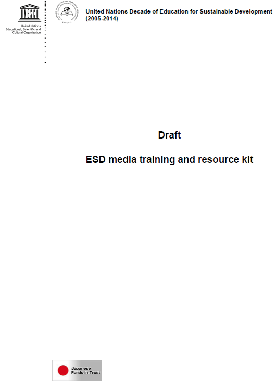C&C endorsements UN Bodies
Some International Agencies that have shown support the C&C Principle
- IPCC Expert Meeting Development Sustainability & Equity
- World Economic & Social Survey Promoting Development Saving the Planet
- World Bank Development Report 2010 Development & Climate Change
- Parliament & Climate Change Responding to Climate Change through International Negotiations
- The Social Dimensions of Climate Change Robert Mearns and Andrew Morton - World Bank
- UNEP - 2011: Decoupling Natural Resource Use & Environmental Impacts from Economic Growth (IRP)
- World Health Organisation; Protecting Health from Climate Change Global research priorities 2009
- UNESCO Commission on Ethics if Scientific Knowledge & Tehcnology
- UN Millennium Ecosystem Assessment Policy Responses
- Faith & the Global Agenda: Values for the Post-Crisis Economy World Economic Forum, DAVOS,2010
- IPCC Third Assessment [Cambridge University Press] Working Group 3 Chapter 1
- IPCC Fourth Assessment [Cambridge University Press] Working Group 3 Chapter 3
- UNDP - Human Development Report 2008
- C&C of Carbon Emissions Journal of Policy Modeling; The Fiscal Implication of Climate Change IMF
- UNEP Financial Initiative - CEO Briefing
- Greenhouse gas emissions reduction DRS the State Council People’s Republic of China 2009
- Africa Group of Nations Position Statement to the UN climate negotiations, August 1997 AGBM
- Third World Network (2007) To the Special UN General Assembly Session on Climate Change
- Stern Review, “the Economics of Climate change” (2006)
- 2009 Global Humanitarian Forum Human Impact of Climate Change
- Act Locally Trade Globally - Emissions Trading for Climate Policy OECD & IEA
- Sustainable Energy Production & Consumption; Barbir Uliati NATO Science for Peace & Security Programme
- "Global Sustainability A Nobel Cause" on C&C
- More extensive support for the C&C Principle is here
"Stabilization inevitably requires Contraction and Convergence."
In others words, ‘UNFCCC-Compliance' is dependent on C&C.
COP-9 Milan 2004 - Joke Waller Hunter UNFCCC Executive Secretary
ZIMBABWE: [for the Africa Group]
“ . . . . . we do support the amendment that is poposed by the distinguished delegation from India, and just to emphasise the point of the issues that still need a lot of clarification would like to propose in that paragraph the inclusion, ater “entitlements” that is the proposal by the delegation of India, the following wording; ater “entitlements, the global ceiling date and time for contraction and convergence of global emissions because we do think that you cannot talk about trading if there are not entitlements, also there is a question of contraction and convergence of global emissions that comes into play when you talk about the issue of equity . . . . . “
"I thank you very much. May I ask again the distinguished delegate of the USA if they have another suggestion to propose in connection with the proposals made by the distinguished delegate of India. He does."
“ . . . . It does seem to us that the proposals by for example India and perhaps by others who speak to Contraction and Convergence are elements for the future, elements perhaps for a next agreement that we may ultimately all seek to engage in."

Raul Estrada -
Chairman Kyoto Protocol Negotiations
Intergovernmental Panel on Climate Change [IPCC]
Contraction and Convergence [C&C] - See http://www.gci.org.uk
"Long before the end of the Framework Convention negotiation, the Global Commons Institute (GCI) has presented a proposal on contraction and convergence,
aimed to reach equality in emissions per capita.
We all in this room know the GCI model where contraction is achieved after all governments, for precautionary reasons, collectively agree to be bound by a target of global GHG emissions, making it possible to calculate the diminishing amount of greenhouse gases that the world can release each year in the coming century, subject to annual scientific and political review. The convergence part of the proposal means that each year's global emissions budget gets shared out among the nations of the world so that every country converges on the same allocation per inhabitant by an agreed date. Countries unable to manage within their shares would, be able to buy the unused parts of the allocations of other countries. The entitlement of rights transferred in this trading is legitimised by the per inhabitant criteria. Level of contraction and timing of convergence should be negotiated on the basis of the precautionary principle. Suggestions for emission reductions are well known and convergence should be achieved at medium term to satisfy legitimacy. I have read that the Chairman of IPCC’s WG I, Sir John Houghton, has said that this is the logical approach. Analysis of C&C in TAR is a must if equity is going to be taken into account in the report."
Proceedings 2nd IPCC Expert Meeting on
Development, Sustainability and Equity
Havana, Cuba 23-25 February 2000
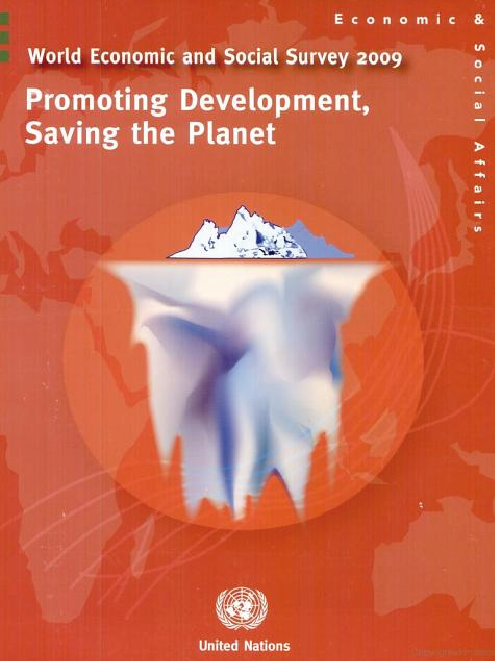
Contraction and Convergence [C&C]. This plan combines equal rights to emit with grandfathering [or assigning rights based on past emissions, the higher the past emissions, the larger the grandfathered emissions rights]. Each country is allocated emissions right based on its past emissions. Countries that exceed desired per capita global emissions have their allocation reduced in each succeeding year, while countries that emit less that this target receive a higher allocation each year. Over time global emissions contract while high an low emitting countries converge on the same per capita emissions [Global Commons Institute].
World Economic and Social Survey 2009,
Promoting Development Saving the Planet
UN Department of Economic and Social Affairs
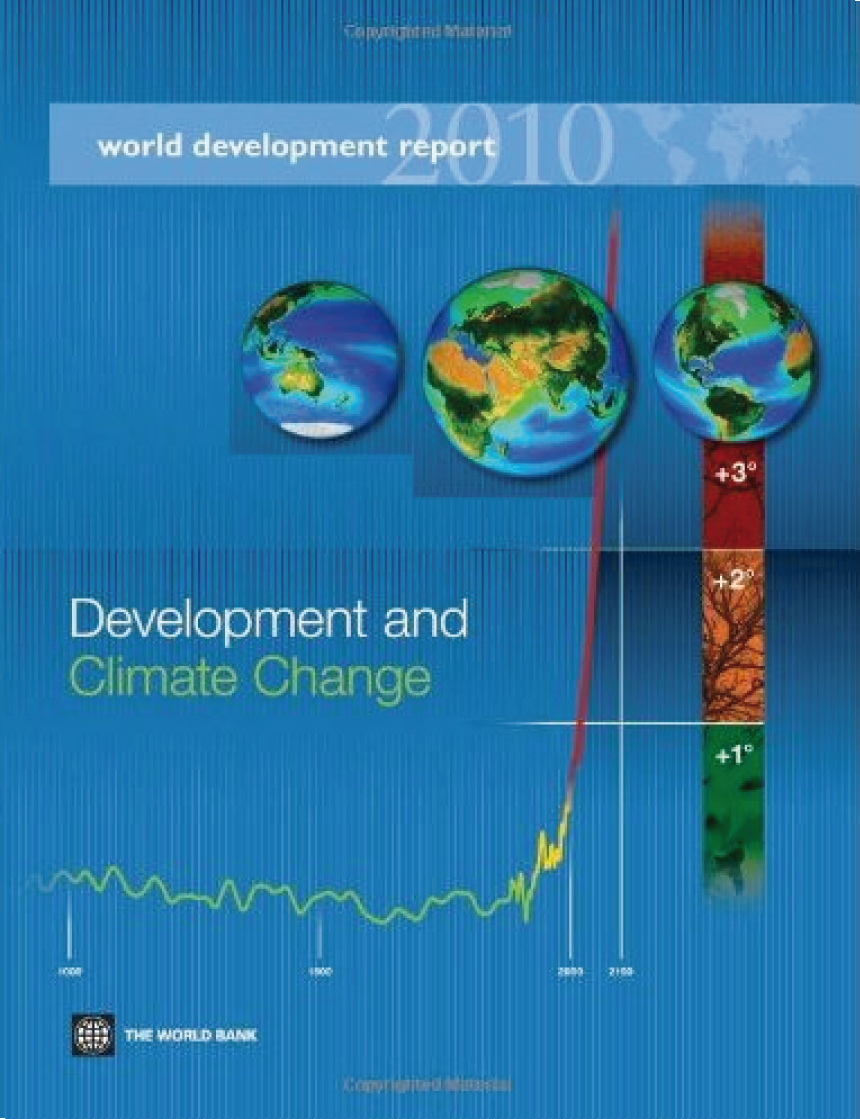
Contraction and convergence
The contraction-and-convergence approach assigns every human being an equal entitlement to greenhouse gas emissions. All countries would thus move toward the same per capita emissions. Total emissions would contract over time, and per capita emissions would converge on a single figure. The actual convergence value, the path toward convergence, and the time when it is to be reached would all be negotiable. [Meyer].
World Bank Development Report 2010
Development and Climate Change

Since August 2007, The World Bank Institute Professional Development program for Parliamentarians & Parliamentary Staff has been available online. By making this series of learning modules publicly available, the World Bank Institute will assist a greater share of the world parliamentary community in fulfilling their role in the governance process.
Contraction and Convergence
While the Kyoto Protocol is the legally binding international regime on climate change, a number of proposals have been put forward as alternatives for future regimes. Brazil proposed setting differentiated emissions reduction targets for Annex I countries ranked according to the impact of their historic emissions on temperature rise. In general, countries with a longer record of greenhouse gas emissions will have a greater share of responsibility for emission reductions than countries where industrialization started later. The proposal was originally designed for application to Annex I countries. However, it could theoretically be applied to developing countries as well. “Contraction and Convergence”, conceived by the Global Commons Institute in the early 1990s, is a framework based on equity. Contraction and convergence uses two principles: contraction of global carbon emissions and convergence of per capita emissions across the world’s population. It proposes reducing overall greenhouse gas emissions to a safe level, or “Contraction”, where global emissions are reduced because every country brings emissions per capita to a level that is equal for all countries, or “Convergence”. The convergence mechanism assists in distributing emission allowances and eventually, at the end of the convergence period, countries will have allowances in proportion to their populations. Developed countries would be the first to make large cuts in their emissions levels, whereas developing countries would be permitted to keep increasing their emissions levels for a period before also beginning to cut their emissions. This framework, intended to form the basis of an international agreement is expressed as a simple mathematical formula, which can be used as a method for stabilizing carbon levels in the atmosphere.
Parliament and Climate Change
Unit 8: Responding to Climate Change through International Negotiations
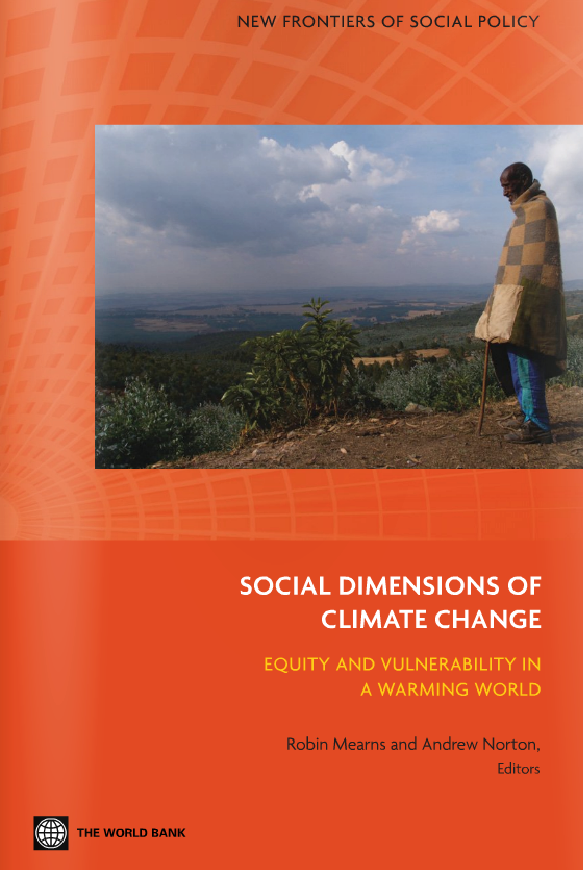
A number of principled proposals have been advanced to help address the enormously complex political question including the Contraction and Convergence approach of GCI. In such proposals emissions are normally calculated on a per capita basis to draw attention to the underlying inequities in historical and current patterns of global consumption.
The Social Dimensions of Climate Change
Robert Mearns and Andrew Morton - World Bank

New York/ Nairobi, 12 May 2011 – By 2050, humanity could consume an estimated 140 billion tons of minerals, ores, fossil fuels and biomass per year – three times its current appetite – unless the economic growth rate is "decoupled" from the rate of natural resource consumption, warns a new report from the United Nations Environment Programme.
Humanity Can and Must Do More with Less: UNEP Report
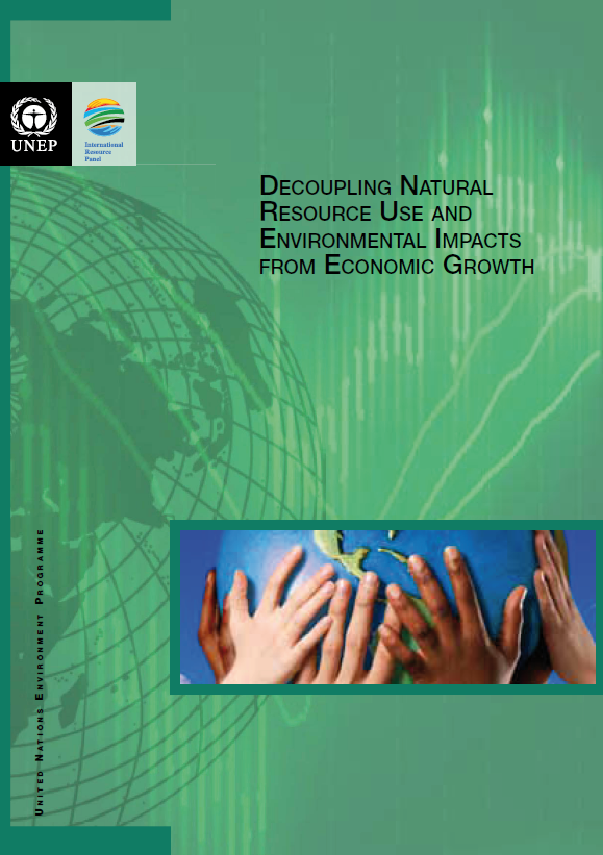
Having reviewed the trends in the use of natural resources and accompanying undesirable
environmental impacts in the first section of Chapter 2, the last section of that chapter
considers possible future implications by presenting three brief scenarios: (1) business as
usual (leading to a tripling of global annual resource extraction by 2050); (2) moderate contraction and convergence (requiring industrialized countries to reduce their per capita
resource consumption by half the rate for the year 2000); and (3) tough contraction and
convergence (aimed at keeping global resource extraction at its current levels). None of
these scenarios will lead to actual global reductions in resource use, but all indicate that
substantial reductions in the resource requirements of economic activities will be
necessary if the growing world population can expect to live under conditions of
sustainable resource management. The key
message of the tough scenario is that despite
population growth to roughly 9 billion
people, the pressure on the environment
would remain roughly the same as it is
now. The emissions correspond
approximately to the lowest range of
scenario B1 of the IPCC SRES, but are still
20% above the roughly 5.5 GtC/yr advocated
by the Global Commons Institute for
contraction and convergence in emissions
(GCI, 2003).
UNEP - 2011: Decoupling Natural Resource Use & Environmental Impacts from Economic Growth
Dr Ernst von Weizsacker, Dr Ashok Khosla,
Co-Chairs International Resource Panel
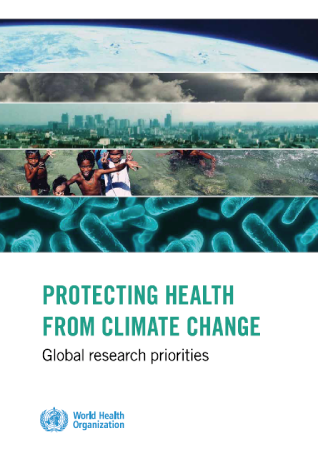
"The few studies that are now beginning to assess the health consequences of
decisions aiming to mitigate or adapt to climate change use very different analytical
methods and assumptions, even for very similar challenges. There is a need to
develop more generic guidance on conceptual frameworks and methods in order
to improve comparability, and assist decision-makers to achieve the greatest health
“co-benefits”, and avoid harm. This should cover the full range of potential decisions,
from the “macro” level for example global contraction and convergence in carbon dioxide
(CO2) emissions; carbon pricing policy and incentives), to more local and sector specific
decisions (e.g. city-level policies to promote public transport, or to protect
a natural watershed)."
Protecting Health from Climate Change
Global research priorities
World Health Organisation 2009

"Carbon emissions must be reduced to avoid the worst outcome of the climate change. Developing economies need rapid economic development so that no country, community or individual is too poor to adapt to climate change. The principle of 'contraction and convergence', conceived by the Global Commons Institute, UK, considers the need to pursue both these actions, reducing global carbon emissions and ensuring economic development of underdeveloped countries simultaneously."
South East Asia WHO -
Climate change is a fundamental threat to human health
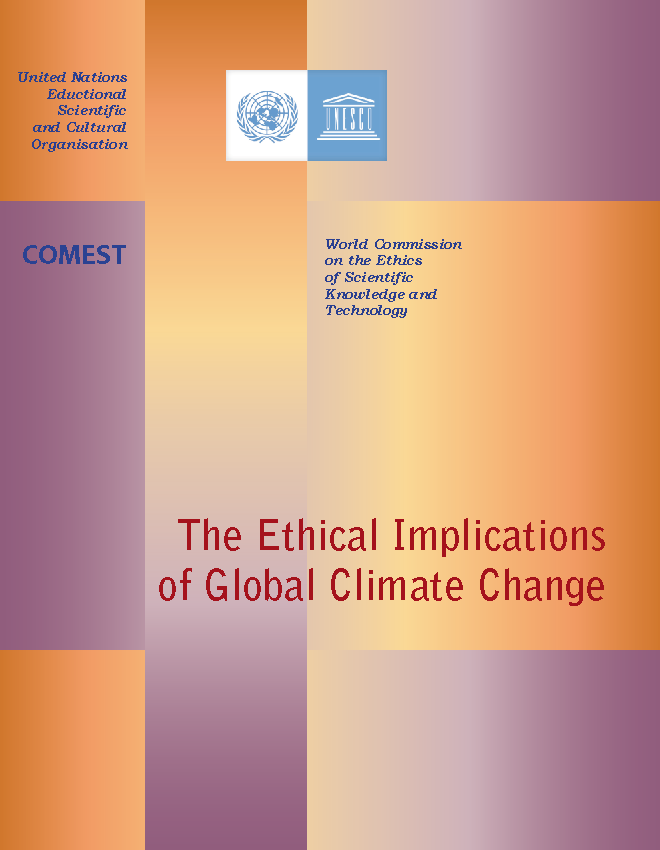
UNESCO COMEST on C&C
"The principle of contraction & convergence refers to the emission of gases contributing to the greenhouse effect. A fair and pragmatic approach, it is argued, would be to move gradually towards quotas that would not be indexed on GOP, as is the case in the Kyoto Protocol, but rather on population, while gradually reducing the permitted total towards the 60% reduction commended by the Intergovernmental Panel on Climate Change (IPCC). Such a principle may be seen as a consequence of both the principles of environmental justice and the principles of earth as global commons. The particular problem whether future emissions allocations should be based on a per capita
basis, as the so-called “contraction and convergence” proposal suggests, or on a country basis,
might be seen in a different light if humanitarian aid were internationally organized on a basis of
each country’s ability to pay. The greater duty of rich countries to contribute to such aid might be
politically easier to accept than more stringent emission limits imposed on “more polluting” and
“past polluting” countries than LDCs (least developed countries), which would also cost “richer”
countries more."Contraction and Convergence (C&C) is the science-based, global climate policy framework proposed to the
United Nations since 1990 by the Global Commons Institute (GCI).
See http://www.gci.org.uk/briefings/ICE.pdf
UNESCO - The Ethical Implications of Climate Change:
A
Report by the
World Commission on the Ethics
of Scientific Knowledge and Technology
(COMEST)
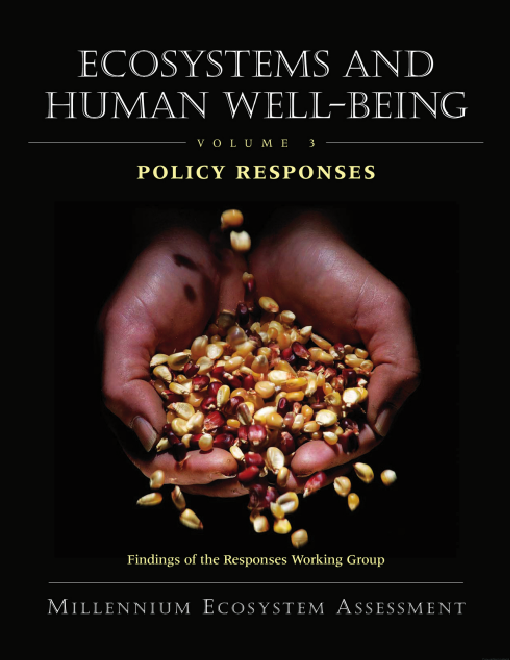
"An
approach that is receiving significant attention, and endorsed by the German Advisory
Council on Global Change, is some form of contraction and convergence whereby total
global emissions are reduced (i.e., contraction) to meet a specific agreed target, and the
per capita emissions of industrialized and the developing countries converge over a
suitably long time period, with the rate and magnitude of contraction and convergence
being determined through the UNFCCC negotiating process. "Contraction and
Convergence” (C&C). C&C is a science-based global climate-policy framework proposed by
the Global Commons Institute (GCI) with the objective of realizing "safe”13 and stable
greenhouse gas concentrations in the atmosphere. It applies principles of precaution and
equity, principles identified as important in the UNFCCC but not defined, to provide the
formal calculating basis of the C&C framework that proposes:
• A full-term contraction budget for global emissions consistent with stabilizing
atmospheric concentrations of greenhouse gases at a pre-agreed concentration
maximum deemed to be “safe” using IPCC WG1 carbon cycle modelling.
• The international sharing of this budget as ‘entitlements’ results from a negotiable
rate of linear convergence to equal shares per person globally by an agreed date
within the timeline of the full-term contraction/concentration agreement.
• Negotiations for this within the UNFCCC could occur principally between regions of
the world, leaving negotiations between countries primarily within their respective
regions, such as the European Union, the Africa Union, the US, etc, comparable to
the current EU bubble.
• The inter-regional, inter-national and intra-national tradability of these entitlements
should be encouraged to reduce costs.
• Scientific understanding of the relationship between an emissions-free economy and
concentrations develops, so rates of C&C can evolve under periodic revision."
UN Millennium Ecosystem Assessment
Policy Responses
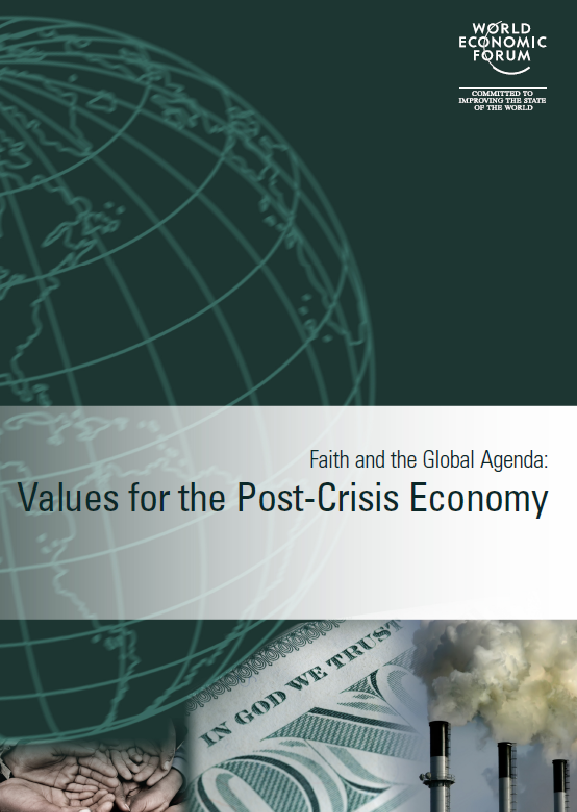
Along with Human Well-Being and Economic Decision-Making, we have to ask about “green taxes” that will check environmental irresponsibility and build up resources to address the ecological crises that menace us. The Contraction and Convergence proposals are among the best known and most structurally simple of these, and it would be a major step to hear some endorsement of them from a body such as this.
Faith and the Global Agenda:
Values for the Post-Crisis Economy
World Economic Forum, DAVOS, Switzerland 2010
- Write a readers' guide to the inadequacies of the Kyoto Protocol (it will reduce greenhouse gases by about 5% if it is fully implemented) and the need for a much more far-reaching agreement to replace it.
- Tell your readers what they can do to reduce their own emissions of greenhouse gases.
- Write an op-ed on the Global Commons Institute's proposal for 'contraction and convergence' - allowing everyone in the world an equal, tradeable right to pollute the atmosphere with greenhouse gases
UNESCO
UNESCO Media Kit
Action points
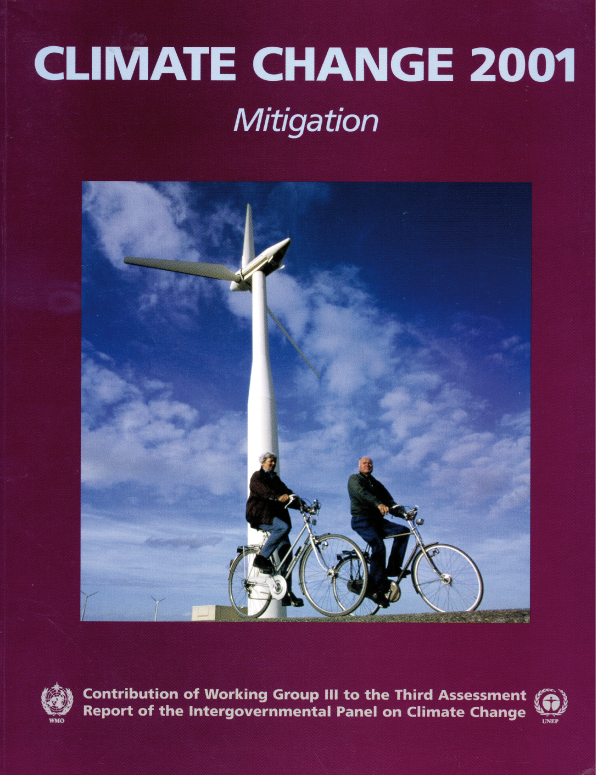
“Rights-based, that is based on equal (or otherwise defensible) rights to the global commons.
A formulation that carries this insight to its logical conclusion is that of “contraction and convergence” (Meyer, 1999), whereby net aggregate emissions decline to zero, and per capita emissions of Annex I and non-Annex I countries reach precise equality.”
IPCC Third Assessment [Cambridge University Press]
Working Group 3 Chapter 1
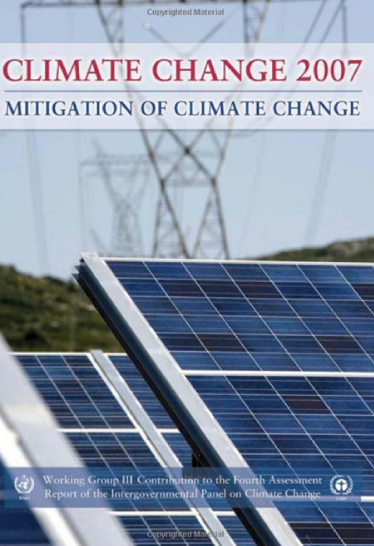
“A number of scenario studies have been conducted for various countries within Europe. These studies explore a wide range of emission caps, taking into account local circumstances and potentials for technology implementation. Many of these studies have used specific burden-sharing allocation schemes, such as the contraction and convergence (C&C) approach (GCI, 2005) for calculating the allocation of worldwide emissions to estimate national emissions ceilings.”
IPCC Fourth Assessment [Cambridge University Press]
Working Group 3 Chapter 3
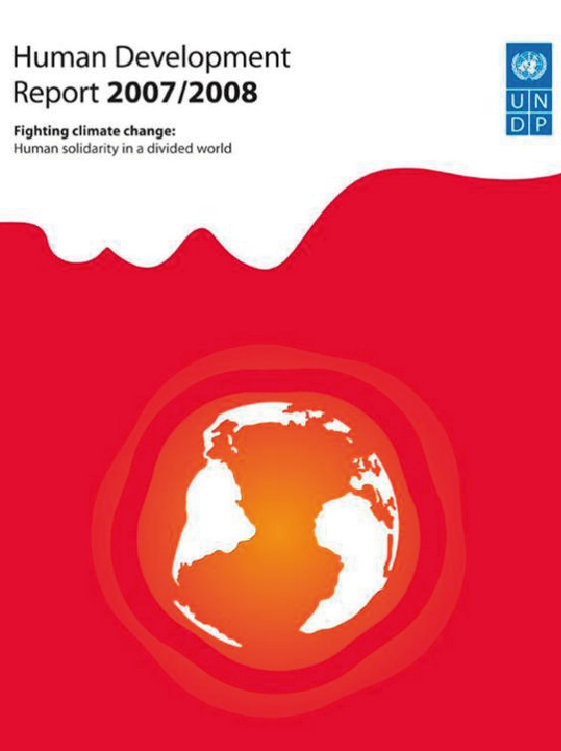
"Contraction
and convergence—
sustainability with equity."
UNDP - Human Development Report 2008
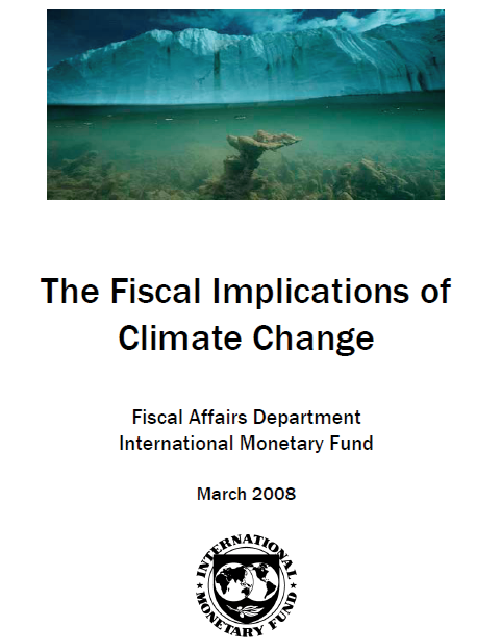
The Global Commons Institute has devised a greenhouse gas
abatement proposal called Contraction and Convergence (Global Commons Institute 1997),
in which the emphasis is placed not only on a significant contraction of anthropogenic CO2
emissions, but also on an equitable per capita distribution of the resulting global carbon budget.
The latter implies a transition to a point (convergence) where future entitlements to emit will
have become proportional to population. The uniform per capita allocation of emission rights
reflects egalitarianism in the sense that all people have inherently an equal right to pollute. The
egalitarian criterion per se has a strong philosophical appeal. However – under contraction of the global carbon budget – it is unlikely to be acceptable for industrialized countries with
currently high per capita emissions unless the transition path allows for long-term “smooth”
adjustment towards the terminal point.
“Contraction and Convergence
of Carbon Emissions: An Intertemporal Multi-Region CGE Analysis,”
Journal of Policy Modeling; The Fiscal Implication of Climate Change
International Monetary Fund
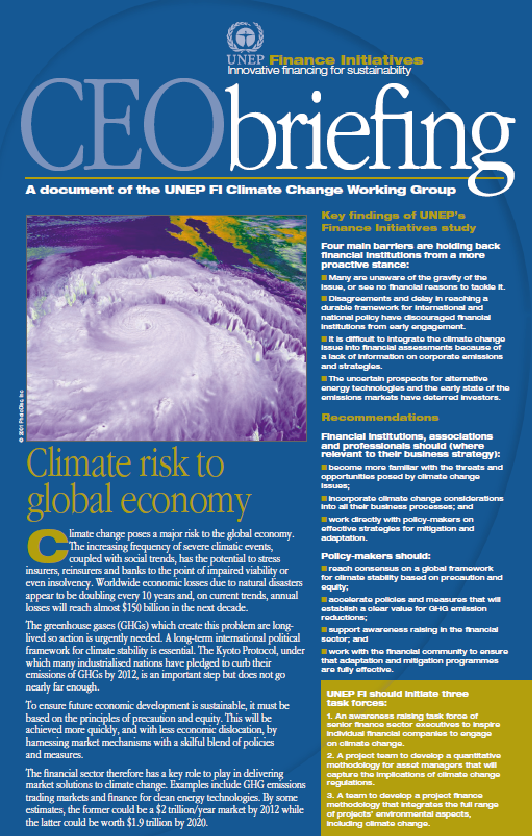
For the long term, the agreement of an international policy based on the principles of precaution,
equity and economic efficiency is critical if we are to reduce the risk and engage all parties in the
endeavour. A number of approaches have been proposed, including the ‘historical’ method, under
which a nation’s future emissions goals would be determined by its past GHG output; the carbon-intensity
approach, in which future emissions goals would be indexed to GDP; and “Contraction
and Convergence” which would aim to achieve equal per capita emissions for all nations by an
agreed date. Up to now, however, most of the work under the United Nations Framework Convention
on Climate Change (UNFCCC) has been directed at finalising and ratifying the Kyoto Protocol.
[For more information on C&C refer to the website of the Global Commons Institute]
UNEP Financial Initiative - CEO Briefing
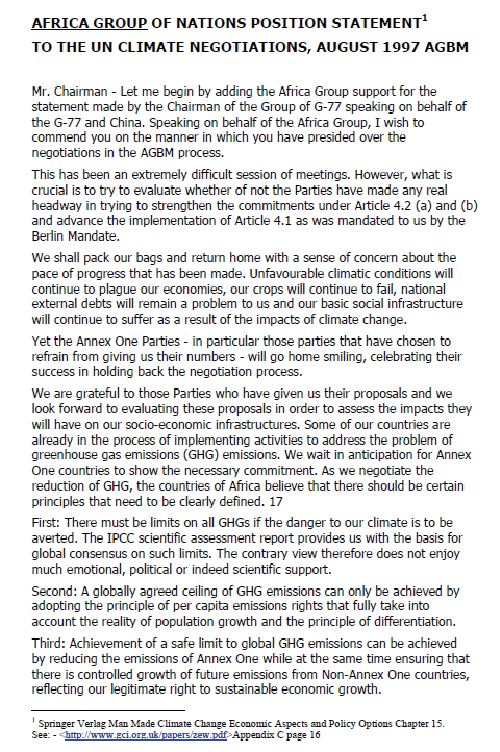
[1] There must be limits on all GHGs if the danger to our climate is to be averted. The IPCC scientific assessment report provides us with the basis for global consensus on such limits. The contrary view therefore does not enjoy much emotional, political or indeed scientific support.
[2] A globally agreed ceiling of GHG emissions can only be achieved by adopting the principle of per capita emissions rights that fully take into account the reality of population growth and the principle of differentiation.
[3] Achievement of a safe limit to global GHG emissions can be achieved by reducing the emissions of Annex One while at the same time ensuring that there is controlled growth of future emissions from Non-Annex One countries, reflecting our legitimate right to sustainable economic growth.
We strongly believe that this will take us along a path to responsible climate management that allows us to reach our goal of defining a mutually agreed point of convergence and sustainable development. Such a convergence Mr. Chairman must ensure that we maintain a global ceiling on emissions to prevent dangerous interference with the climate system.
[4] When we look at time frames, we believe that insufficient commitment by Annex One countries will only result in delaying our influence on the climate system. If this course is maintained, then we will all suffer and the burden will be even greater for humanity in general. The burden for any future mitigation efforts on those of who have not been historically and currently responsible for creating the problem will be greater.
Africa Group of Nations Position Statement
to the UN climate negotiations, August 1997 AGBM

It is more equitable and fair to consider the per capita emission concept and data. This is because some countries have large total emissions mainly because of their huge population sizes, and not because of the emission intensity. The principle of “contraction and convergence” would be equitable and thus more capable of winning support by more people. In this principle, the world as a whole has to contract or reduce its total emissions. In doing so, an equitable principle is used. Take the total maximum emission level that is sustainable, i.e. that the world is able environmentally to sustain. Divide this total by the world’s population. That level of emission per capita could be considered the “emission right” or “emission entitlement” per person.
Martin Khor -
Director
Third World Network - August 2007
To the Special UN General Assembly Session on Climate Change
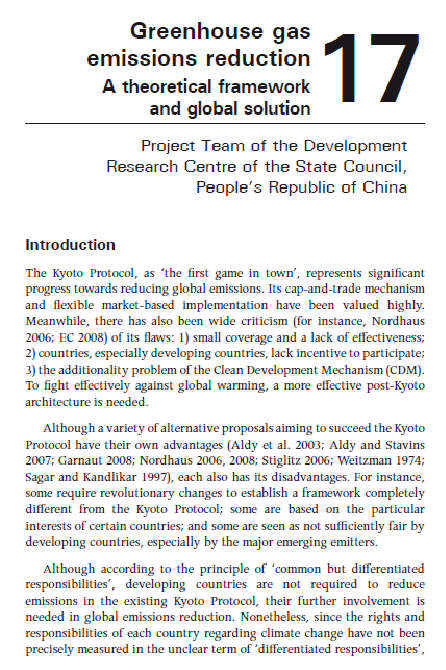
Contraction and convergence
Since the principle of ‘contraction and convergence’ was first proposed by the Global Commons Institute in 2000, it has been widely embraced by some industrialised countries. Under contraction and convergence, each country will start out with emission entitlements equal to its current real emissions levels, and then, over time, converge to equal its per capita entitlements, while the overall global budget contracts to accommodate the emissions reduction objective. The convergence principle should be applied immediately rather than later as the ‘converged point’ in the future. ‘Real emissions’ is a different concept to ‘emissions entitlement’. A country’s high/low per capita real emissions cannot justify its high/low emission entitlements. In the process of convergence, the rights and interests of country B are really infringed by country A. In the NEA-based solution, the concept of convergence can still be incorporated, but it now merely means ‘convergence of real emissions’ rather than ‘convergence of emission entitlements’. Each country’s gaps between its emission entitlements and real emissions need to be balanced by the traded emissions quotas.
Greenhouse gas emissions reduction - a theoretical framework and global solution
Development
Research Centre of the State Council
People’s Republic of China 2009

Key Recommendations
In light of the growing human impact of climate change and the pressures
of this crisis for humanitarian and development work, the following is a list
of key recommendations made by the different discussion groups at the
2009 Forum.
Climate vulnerable coalition
Those nations most vulnerable to the impacts of climate change should
form a common front in order to increase awareness on the impact
and risks of climate change, share expertise relating to climate change
policy, and influence the development of safe and equitable international
climate change policy, in particular with the strongest possible impact
on the 2009 UN Climate Conference at Copenhagen
Future international climate change agreement
1. The principle of contraction and convergence with a population base
year should provide the basis framework for global greenhouse gas
emission reductions
2. “No deal is better than a bad deal”: it would be more constructive to
avoid conclusion at the 2009 UN Climate Conference at Copenhagen of
any climate change agreement that would not provide for basic levels of
safety, equity and predictability
3. All parts of civil society should make a concerted attempt to create wide
multi-stakeholder partnerships for concentrating pressure for a successful
conclusion to the Bali Road Map and the Copenhagen Conference."
2009 Global Humanitarian Forum
Human Impact of Climate Change
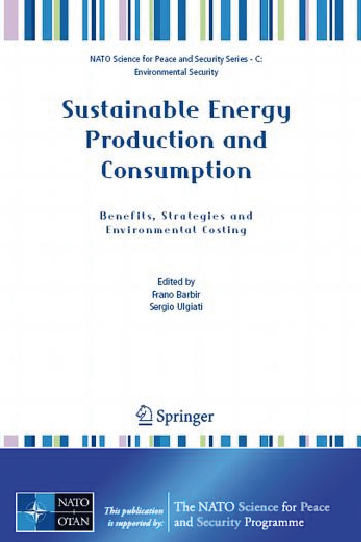
Contraction and Convergence model provides one transparent solution with equal per capita emissions for the mitigation of COs emissions The model requires considerable emissions reductions which, according to our study, seem to be possible when the changes arc analyzed from the point of view of emissions intensity development. According to the Fourth Assessment Report of the IPCC a considerable reduction of greenhouse gas (GHG) emissions is required in order to prevent dangerous anthropogenic interference with the climate system. Various different approaches have been proposed to allocate commitments regarding the future greenhouse gas emission mitigation for different countries. One of them is the Contraction and Convergence (C&C) model of future GHG emissions (GCI. 2003). The C&C approach defines emission permits on the basis of converging national GHG emission rates to an equal level which is based on per capita emissions under a contracting global emission profile. In this study we have used a target of 1.8 tons of CO2 per capita. which should be achieved by all countries by a designated year, 2040. This satisfies the requirement set by IPCC to reduce the total emissions by 50 to 85% from the 2000 level in order to limit the global temperature increase to 2-2.4°C. The purpose of this paper is to analyze what the C&C approach might mean for the examined countries and to analyze the potential changes that are needed in the emission intensities of the selected countries in order to achieve their C&C targets. For further information on the data and methodology used in this study please see GCI (1998, 2003). (IEA (2003 a. b. e) and (UN 2003) for data sources and Luukkanen et al. (2005) for methodology.
Sustainable Energy Production and Consumption - Frano Barbir Sergio Uliati
NATO Science for Peace and Security Programme
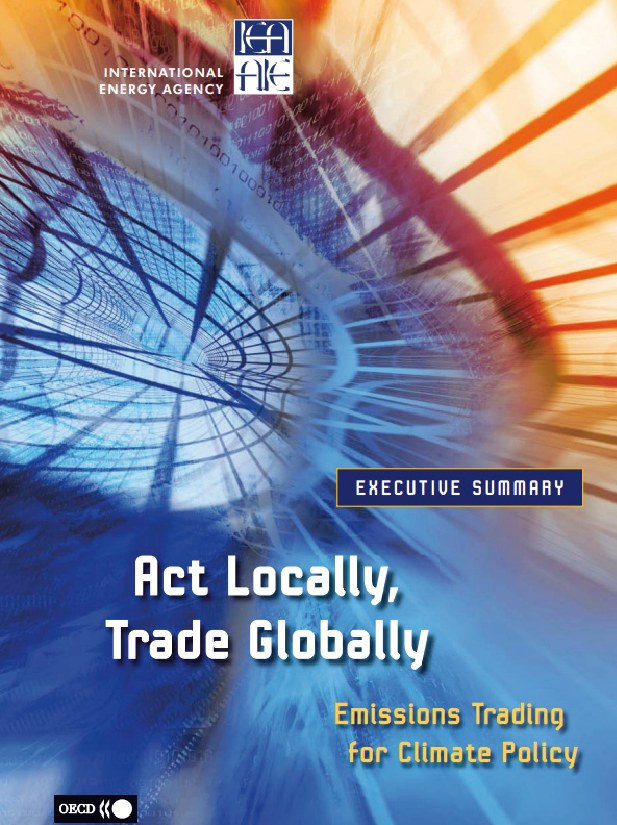
Some proposals compensate the potential burden on developing nations with generous emissions allocation, whether as a simple strategy to obtain developing countries support for the regime or in a realisation of the global equity principle borrowed from social justice. A famous such proposal is “Contraction and Convergence” developed by Aubrey Meyer.
Act Locally Trade Globally - Emissions Trading for Climate Policy
Organisation for Economic Cooperation and Development OECD & IEA

"The contraction and convergence policy option proposes that equalizing global per-capita emissions across countries would ensure equity in the global climate change mitigation process. It supports climate change negotiations that aim to equalize per-capita emissions at a future date, with the levels of permissible global per-capita emissions and the different years by which the emissions have to be equalized varying according to several formulae. This would allow citizens of all countries, regardless of size or level of development, equal space in the atmosphere, and thus equal responsibility to mitigate. While there are concerns that contraction and convergence may provide incentives to high population growth rates, it is entirely feasible, and indeed widely proposed, to place a limit on population beyond which no further entitlements would be granted. Furthermore, countries with high population growth rates would still have to provide resources for their growing populations. Therefore, the economic incentive to encourage high population growth rates may not even exist."
"Global Sustainability
A Nobel Cause" on C&C

